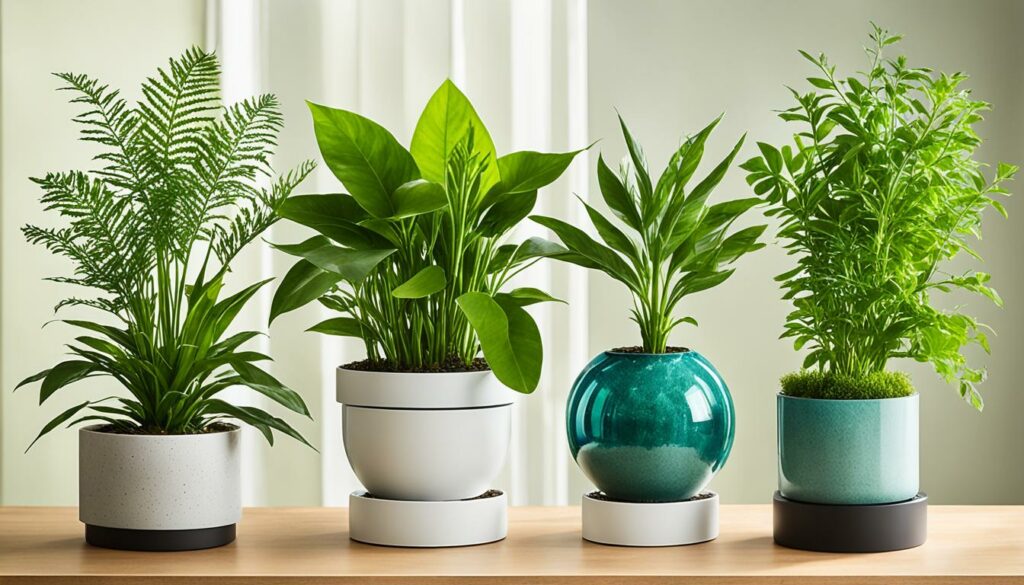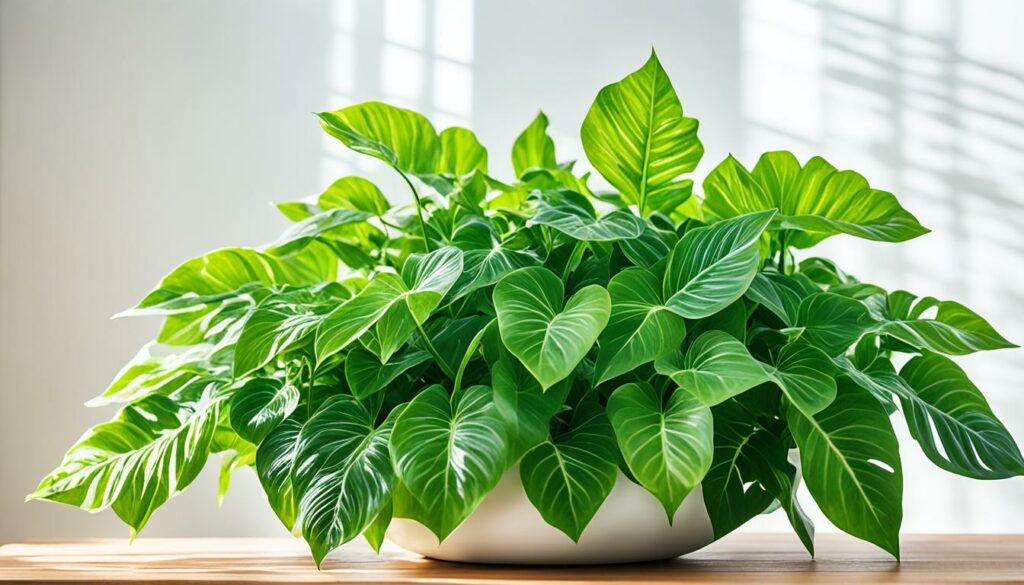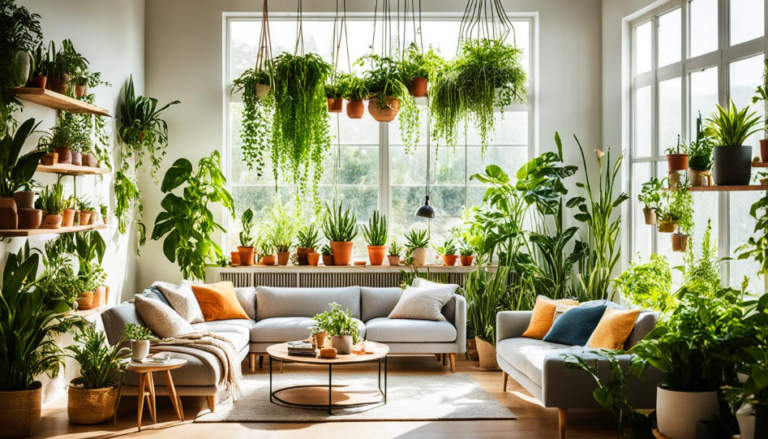In today’s fast-paced world, we often feel cut off from nature. But did you know we spend over 85 percent of our lives inside? This shows how vital it is to make our indoor spaces feel connected to nature1. Adding indoor plants, or “houseplants,” can change that. They bring in natural beauty, better air, and many health perks.
Houseplants are more than just pretty things. They’re living friends that can greatly improve our health and mood. Studies show they can make us happier, more focused, and more creative1. They also clean the air by taking in harmful toxins1. Plus, they add moisture and produce oxygen, making our homes healthier.
Indoor plants bring life and color to dull spaces. They make our homes look better and feel calmer. Taking care of them is a way to connect with nature and feel hopeful1.
Key Takeaways
- Indoor plants can improve air quality, reduce stress, and boost mood and productivity.
- Houseplants add life, color, and a natural aesthetic to any indoor space.
- Caring for plants can be a mindful, therapeutic activity that connects us to nature.
- Plants absorb carbon dioxide and release oxygen, improving the air we breathe.
- Incorporating indoor plants into your living and work spaces can have a profoundly positive impact on your overall well-being.
The Power of Biophilia: Our Innate Connection to Nature
Humans have a natural urge to connect with nature, known as the biophilia hypothesis. This idea was brought up by biologist Edward O. Wilson. He said our biology makes us want to connect with life, whether it’s people, animals, or nature2. As cities grow and we spend more time with technology, this idea is more important than ever.
The Biophilia Hypothesis and Its Relevance Today
The biophilia hypothesis says our love for nature is not just a choice but a basic need2. With over half the world living in cities and Americans indoors most of the time, bringing nature into our lives is crucial2. By meeting our biophilic needs, we can improve our health and keep a strong bond with nature.
How Indoor Plants Can Satisfy Our Primal Need for Nature
Indoor plants are a great way to feed our biophilic instincts. They let us use our senses and feel the benefits of nature2. Studies show that plants in homes can boost mental health and well-being3. They also make us more productive and lower stress3.
Biophilic design is about making indoor spaces better by using nature’s elements like natural light and plants2. This approach helps us feel calm, think better, and connect with nature indoors3.
Indoor plants come in many forms, from green walls to edible herbs and natural light2. They help us reconnect with nature and meet our biophilic needs. By using biophilia, we can make our homes into places that support our health and spirit23.
Unlock the Health Benefits of Indoor Plants
Adding indoor plants to your space brings many health benefits. Plants take in carbon dioxide and give out oxygen4. They also add moisture vapor, making the air more humid4. But they do more than just clean the air. They help your body and mind too.
Improved Air Quality and Reduced Toxin Levels
The NASA Clean Air Study showed that houseplants can clean indoor air4. They catch pollutants and turn them into energy, giving you cleaner air4. Plants like Snake Plant, Philodendron, and Pothos are great at removing toxins like formaldehyde and benzene5.
Stress Reduction and Increased Well-Being
Studies show that plants can make you feel calm and relaxed6. Taking care of plants can lower stress and make you happier4. It can even help you think better and remember things4.
Adding plants to your home or office can make you more productive and creative6. It can also help you sleep better6. So, if you want cleaner air, less stress, or just a touch of nature indoors, indoor plants are the way to go5.
“Surrounding yourself with plants can have a calming and soothing effect, lowering stress levels and improving overall well-being.”
Indoor Plants Add Life to Any Space
Adding houseplants brings nature inside, turning a dull space into a lively, calming place7. Studies show that homes with plants are better for our health and mood7. Being near greenery can reduce stress and make us feel better7. Plants also clean the air, making our homes healthier7.
More people are choosing indoor plants now, offering many options for everyone7. You can pick from easy-care plants like ZZ plants and spider plants, or go for something more elegant like orchids8. There are so many ways to make your space a plant paradise.
Styling your indoor plants is fun and creative9. Mix different plants with various colors and shapes for a unique look9. Add personal items like books and art to make it your own9. Remember, think about size, balance, and color to make your plants look great9.
Indoor plants are great for better air, less stress, or just bringing nature inside7. They’re easy and effective. So, let’s bring some green friends into our homes and enjoy the benefits of biophilic design7?
NASA’s Clean Air Study: The Science Behind Plant Power
In 1989, NASA’s Clean Air Study showed how houseplants can clean indoor air10. It found plants like Bamboo palm, English ivy, and Peace lily can remove harmful substances from the air10.
How Plants Remove Indoor Air Pollutants
Plants can take in pollutants through their leaves and send them to their roots10. There, the toxins become food for the plant. Soil microbes also help by breaking down pollutants like benzene10.
Best Air-Purifying Houseplants According to NASA
- Peace lily
- Bamboo palm
- Aloe vera
- Boston fern
While the NASA study was hopeful, newer research has shown mixed results10. The study’s small size and controlled setting might not apply to real life11. Still, it has sparked ongoing research into how plants can improve air quality11.

“The NASA study found plants could clean air in a closed environment, but may not be as effective in real-life settings.”11
The NASA study is a key study on how indoor plants clean the air11. But, it’s important to remember that plants aren’t a complete solution for air pollution11. They can still make our homes and workplaces nicer and healthier11.
Creating a Green Sanctuary: Design Tips and Inspiration
Turning your space into a lush, green oasis is simpler than you think. By picking the right indoor plants, you can make a peaceful green sanctuary inside12. Think about the light, humidity, and safety when choosing and placing your plants.
Incorporating Plants into Your Space
Whether you’re a pro or a newbie, there are many ways to add houseplants to your decor. Big plants like Palms or Ficus trees can stand out, while small succulents and vines add fun12. Mixing plants of different sizes and colors makes your space look full and interesting.
Vertical gardens and hanging planters are great for small spaces, letting you show off your botanical decor without taking up too much room13. Adding natural light and colors that remind you of nature makes your green sanctuary feel more real13.
The #HousePlantClub: An Online Community for Plant Lovers
For inspiration and advice on your plant oasis, check out the houseplant community online. The #HousePlantClub hashtag and special accounts are full of great tips and beautiful plant ideas13. Talking with other plant enthusiasts can also help you learn how to keep your indoor plants healthy.
“Bringing the outdoors in through biophilic design can have a big effect on our well-being and connection to nature.” – Jane Doe, Interior Designer
Low-Maintenance Houseplants for Beginners
For those new to indoor gardening, there are several easy-to-care-for houseplants to consider. Spider plants and philodendrons are great for beginners. They are easy to take care of and look great1415.
Spider Plants: The Unkillable Multipliers
Spider plants are known for being tough and easy to care for. They can grow in many lighting conditions, from bright to low light14. They also produce “baby” plants, or pups, that you can easily share with others14.
Philodendrons: Vining Beauties for Low-Light Spaces
Philodendrons are another great choice for beginners. They have beautiful vines and leaves that can grow in low light1415. They are easy to care for and look beautiful, making them perfect for beginners.
Other easy plants for beginners include peace lilies, English ivy, and ZZ plants1416. These plants need little care but can bring beauty to your home.
“The key to success with indoor plants is choosing the right species for your environment and providing the appropriate care. Start with low-maintenance options, and you’ll be well on your way to creating a thriving indoor oasis.”
| Houseplant | Lighting Requirements | Watering Frequency | Other Care Tips |
|---|---|---|---|
| Snake Plant | Bright indirect light to low light | Water every 2-4 weeks | Drought-tolerant, fertilize monthly in summer |
| Pothos | Bright indirect light to low light | Water every 10-14 days | Trailing vines, prune to maintain shape |
| Aloe Vera | Bright indirect light | Water every 2 weeks | Succulent, allow soil to dry between waterings |
| Rubber Plant | Bright indirect light | Water every 10-14 days | Large, glossy leaves, prune to control size |
Adapting plant care to mimic natural conditions helps your indoor plants thrive14. Slowly introducing plants to new environments helps them adjust and grow14. With the right plants and care, you can make a beautiful green space at home151416.
The Therapeutic Benefits of Indoor Gardening
Caring for indoor plants can greatly improve our mental health. Studies show that plants help reduce stress, boost focus, and lift moods17. Tending to plants makes us feel calm and mindful, keeping us in the moment17.
Improving Cognitive Function and Memory
Research also finds that indoor plants can boost short-term memory and fight mental fatigue17. The idea that humans naturally want to connect with nature, known as the biophilia hypothesis, might explain why office workers with plants feel better18.
Cultivating a Sense of Calm and Mindfulness
Studies show that indoor plants are good for our mental health and school performance17. They also look at how plants affect our feelings and physical health, showing they’re key to our well-being17.
| Therapeutic Benefits of Indoor Gardening | Key Findings |
|---|---|
| Stress Reduction and Increased Well-Being | – A study highlighted the stress recovery benefits during exposure to natural environments17. – A systematic review indicated evidence of added health benefits from exposure to natural environments17. – Research has shown mental health benefits from long-term exposure to residential green and blue spaces17. – A meta-analysis indicated the positive effect of contact with natural environments on emotions17. |
| Improved Cognitive Function and Memory | – Experimental literature reviews highlighted the psychological benefits of indoor plants17. – Research emphasized the contributions of indoor nature to well-being and academic outcomes among students17. |
| Enhanced Air Quality and Reduced Health Complaints | – The NASA Clean Air Study from 1989 indicated that houseplants and their associated microorganisms can remove volatile organic compounds from indoor air18. – Interventions with indoor foliage plants in classrooms were linked to improved air quality and reduced health complaints17. |
“The biophilia hypothesis suggests that humans have an innate tendency to seek connections with nature, animals, and other forms of life, which is deeply rooted in biology.”18
Looking after indoor plants does more than just help our bodies. It also boosts our mental health in big ways. From lowering stress and improving memory to making us feel calm and mindful, indoor gardening is amazing. By adding nature to our homes, we connect deeper with the world and improve our overall well-being.
Bring the Outdoors In: A Symbiotic Relationship
The bond between humans and indoor plants is truly special. We take care of our houseplants, and they give us many benefits. They improve air quality, boost our mood, and help our well-being. By bringing nature indoors, we enjoy the healing effects of nature, even when we can’t go outside19.
This symbiotic relationship shows our deep connection to the living world. It highlights the need to keep that bond strong, even in busy cities20.
Research shows that indoor plants can cut stress and bad feelings by up to 40% for office workers19. NASA scientists found that plants help with Sick Building Syndrome, caused by poor air quality19.
Also, bringing outdoors in helps our minds and feelings. Being around Mycobacterium vaccae, a soil bacteria, boosts serotonin. This improves mood, digestion, and feelings20. Just 30 minutes with houseplants or nature lowers stress hormones, bringing balance20.

Adding plants to our homes creates a symbiotic relationship that helps both plants and people. This bond gives us a sense of stability and reminds us of our connection to nature20.
Whether it’s a small indoor garden or a few plants at work, bringing the outdoors in changes our well-being and happiness for the better21.
Conclusion
Indoor plants are more than just decorations. They are living friends that help your health. They bring nature inside, meeting our need for connection with the outdoors. This brings better air quality, less stress, and sharper minds22.
Adding houseplants to your space is easy and rewarding. It helps you build a strong bond with nature2223. These plants clean the air, lift your mood, and help you focus better2223.
Exploring botanical decor and biophilic design shows us the value of indoor plants. They’re not just decorations; they’re living beings that make our lives better in many ways2223. Let your houseplants be a key part of a healthy, vibrant life2223.
FAQ
What are the benefits of having indoor plants?
Indoor plants can make us happier, more productive, and creative. They help us focus better and reduce stress and tiredness. These plants clean the air by taking in toxins and making oxygen.
They also make spaces look alive, offer privacy, and lower noise levels.
What is the biophilia hypothesis and how does it relate to indoor plants?
The biophilia hypothesis, by biologist Edward O. Wilson, says humans naturally want to connect with life and nature. Having houseplants indoors meets this need, helping us feel connected to the outdoors.
How do indoor plants improve air quality?
The NASA Clean Air Study found houseplants and their tiny life can remove harmful chemicals from the air. These plants catch pollutants and turn them into energy, giving us cleaner air.
What are some easy-to-care-for indoor plant options?
Spider plants, philodendrons, peace lilies, English ivy, and ZZ plants are perfect for beginners. They don’t need much care and can grow well in different light conditions.
How can caring for indoor plants benefit mental well-being?
Studies show that plants can lower stress, boost focus, and lift moods. Taking care of plants helps us relax and be mindful. It makes us live in the moment.
Being around indoor plants can also improve memory and help us bounce back from mental exhaustion.
- Growing Bonsai: Tips for Miniature Tree Enthusiasts
- Buying Bonsai: Tips for Selecting Your Perfect Tree
- Bonsai Potting: Essential Tips for Tree Care Success
- Bonsai Maintenance: Essential Care for Tiny Trees
- Mastering the Art of Shaping Bonsai: A Beginner’s Guide
Source Links
- Health benefits of indoor plants – https://www.piedmont.org/living-real-change/health-benefits-of-indoor-plants
- Biophilic Design & The Power of Indoor Plants In Our Homes – https://outsideinco.com/blogs/learn/biophilic-design-the-power-of-indoor-plants-in-our-homes
- The Health Benefits of Biophilia Plants in Interiors — wellness design consultants – https://biofilico.com/news/air-purifying-plants-healthy-biophilic-interiors
- Greening Your Space: The Beauty and Benefits of Indoor Plants! — J. Miles Design – https://www.jmilesdesign.com/blog/greening-your-space-the-beauty-and-benefits-of-indoor-plants
- The Health Benefits of Indoor Plants – InDependent – https://in-dependent.org/the-health-benefits-of-indoor-plants/
- The surprising health benefits of house plants – Boomer Eco Crusader –


